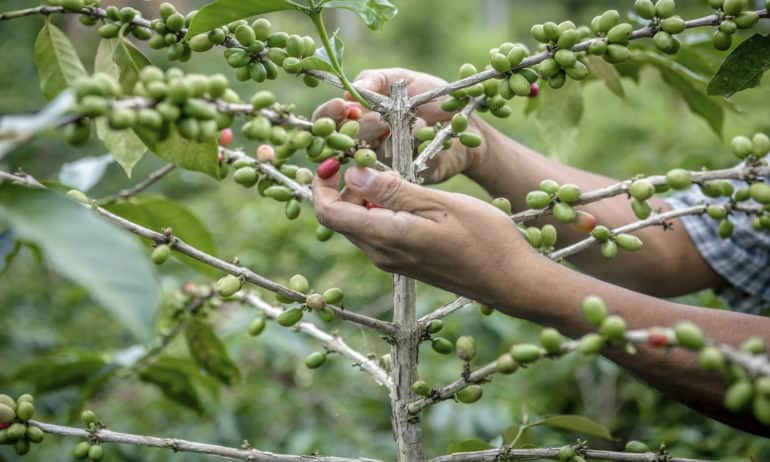The Sustainable Coffee Challenge has recently announced the first four Collective Action Networks that will catalyze the effort to make coffee the first sustainable agricultural product in the world. The coalition, assembled by Conservation International, has more than 65 partners including corporations, governments, NGOs, and research organizations such as Fairtrade America, USAID, and Starbucks.
Food Tank had the opportunity to speak with Bambi Semroc, who leads the Sustainable Coffee Challenge, which is spurring the global effort to address the growing threats to the coffee industry.
Food Tank (FT): Why did you choose coffee to become the world’s first sustainably sourced commodity?
Bambi Semroc (BS): We chose coffee to become the first sustainable agricultural product for a couple of reasons. First, the coffee sector has been working to advance sustainability for nearly 20 years and has one of the longest histories of doing so. The most recent State of Sustainability Report that looks at sustainability for a number of agricultural commodities, noted that 40 percent of coffee production is being produced according to a thirdparty verified sustainability standard. This was the highest of any commodity the study reviewed. So, given the long history of working on sustainability, the tremendous advances made to date, the desire among the sector to work together on sustainability, and the ability to see the product from tree to cup, we chose coffee to lead. Conservation International also has a long history of working on sustainability in the coffee sector, both in the field with farmers and with corporations on sustainability programs and sourcing commitments.
FT: Could you explain the major challenges and potential threats facing the coffee sector?
BS: Although we have been working on sustainability in coffee for over two decades, the sector continues to face significant challenges. These include: an aging farmer population and a younger generation less interested in becoming coffee farmers, aging coffee trees that are less productive and often have been hit by pests and diseases, volatile markets that create uncertainty among farmers about their continued ability to make a viable future out of coffee, and climate change threatens to make half of the suitable area for coffee to become less suitable and push coffee into higher altitudes that are usually the last remaining intact forests. All of these affect coffee communities, the migrant laborers that maintain and harvest the coffee, and the broader ecosystems that provide the freshwater, forest products, and other benefits to coffee and the producer communities.
FT: Who are the key actors involved in the Sustainable Coffee Challenge coalition, and how will they work together to tackle these challenges?
BS: The Sustainable Coffee Challenge is a partnership of over 67 stakeholders from across the coffee sector. It represents retailers, roasters, traders, governments, certification organizations, NGOs, research organizations and others all aligned with the vision of making coffee the first sustainable agricultural product. A list of partners is available here.
These stakeholders have been working together for the past 17 months via working groups to understand better our current interventions and how they work together to address the challenges facing the sector. This resulted in the launch of a Commitments Hub where partners can publicly state their sustainability commitments and report on their progress, the Sustainability Catalogue 2016 in which we identify more than 80 stakeholders taking action to address sustainability issues, and a Sustainability Framework to help make sense of these disparate programs. We did this to better understand what is being done, how these interventions work together, and to identify opportunities for further alignment and collaboration across the sector. While we continue to update the Hub, and develop a Sustainability Framework 2.0 and identify common indicators for reporting on progress, we are beginning the pivot to collective action among the partners.
On April 17, we issued a press release announcing the launch of our first four Collective Action Networks that the Challenge will form to address key sustainability issues facing the sector: coffee farm renovation and rehabilitation, improved labor practices and labor supply, scaling up sustainable sourcing commitments, and coffee and forest mapping and monitoring. These are intended to be complementary to emerging or existing collaborative efforts to address other key issues like gender, climate change, etc. The idea is for the action networks to undertake a 100-day process to set forth an agreed action plan with clear milestones and targets.
FT: Could you give some examples of targets or milestones the Collective Action Networks might establish?
BS: Targets and milestones will vary according to the needs of the action network. One example of a target in discussion is 1 billion trees for the renovation of coffee farms as a call to action to expand upon the existing renovation efforts. Others might focus on key milestones regarding sharing and cataloging approaches, developing guidance or how-to documents, issuing a call to action and getting additional commitments, for example. This is what we are working on via the 100-day process for these four initial networks.
FT: How can individuals engage with the Sustainable Coffee Challenge?
BS: The success of the Challenge hinges on the engagement and active participation of motivated people to tackle head on some of the biggest threats facing the sector. We think of it as a social movement of like-minded individuals and organizations working together toward our ambitious vision. Individuals engaging can take many forms: they may be coffee farmers, government representatives, NGO workers, corporate representatives and researchers all wanting to engage directly and influence the sustainability agenda for coffee. Consumers can also support the work of the Challenge by asking questions about sustainability in coffee and choosing coffees from companies, farmers, and regions that have made clear commitments to sustainability and are making clear progress towards those goals.













